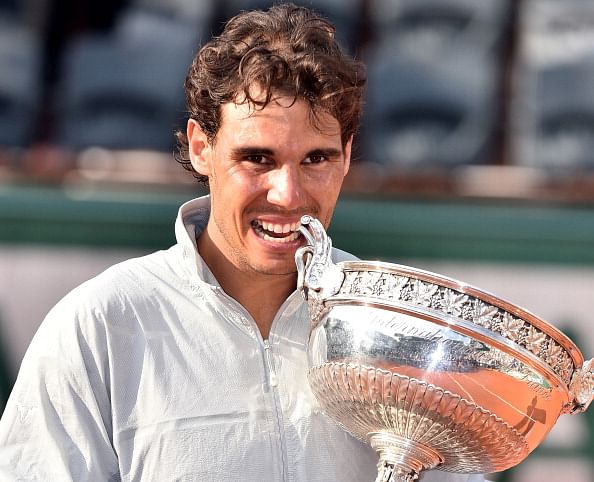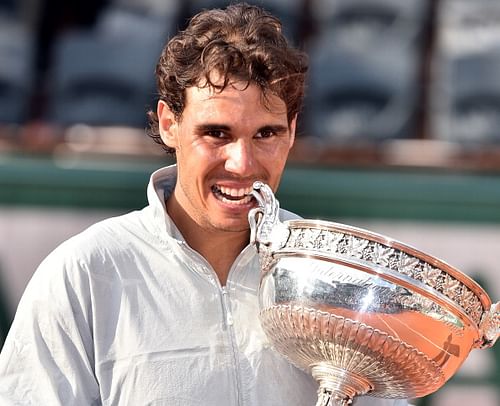
Rafa Nadal - a true warrior

When we think of some of the greatest athletes in sports, a number of factors come to mind, which set these players apart from the rest of the field. A champion always has that extra bit of talent, skill, motivation and desire to be best of the best. A well-known Spaniard by the name of Rafael Nadal is without a doubt one of the greatest athletes and champions to have ever set foot on a tennis court, and he possesses all of those qualities, and then some, that define sporting legends.
Start of a glittering career
The world first witnessed the champion in the making when he took to the claycourts of the French Open in 2005 at only 19 years of age. This appearance turned into a remarkable feat; in his debut French Openand on his way to winning the first Grand Slam of his illustrious career, he took out the then number one Roger Federer in the semifinal. After winning the final against Mariano Puerta of Argentina, the Spanish teenager immediately came under the spotlight.
This was only the beginning of Nadal’s march towards stardom. Most of his early career saw him being tagged as just a claycourt specialist. Even though he possessed the game to excel on hardcourts and on grass, the results did not do justice to it.
If we take a look at the most important tournaments during the calendar year, then apart from the Grand Slams, the Masters 1000 category tournaments are considered as the next biggest. A tennis player’s greatness is more or less judged according to the results of Grand Slams and Masters’ tournaments.
Between the years 2005 to 2007, Nadal had won on the red clay of Monte Carlo Masters, Rome Masters and the French Open for three years in a row. In the same period he had four Masters titles on hardcourts but no Grand Slams. On the famous Wimbledon grass, Nadal failed to get past the final hurdle on two consecutive occasions. Hence, as far as the general notion went, clay was regarded as Nadal’s favourite surface and he was aptly known as the ‘King of Clay’.
Career Grand Slam and a player for all surfaces
It was in 2008 that Nadal truly began to prove his critics wrong. He continued his stellar dominance on clay, but it was the consecutive Slam victories at the French Open and Wimbledon which marked the beginning of his overall dominance. With his Wimbledon victory, he became only the third man in the Open Era to win the French Open and Wimbledon back-to-back, achieved earlier only by Rod Laver in 1969 and by Borg in 1978-80.
Nadal’s victory at SW19 was a classic affair, as he went toe-to-toe with Roger Federer, arguably the best tennis player of all time, for the third successive year. It was the longest Wimbledon final ever and was also hailed as the best match of all time by many greats of the game.
2009 started off with a bang for Nadal as he captured his first Australian Open title, and with it he had captured Grand Slams on all three surfaces. This victory also made him only the fourth man to have won Grand Slams on all three surfaces. The spectators were treated to a near inhuman display in Melbourne, as he fought through two marathon five-set matches in the semifinal and the final to emerge victorious.
In 2010, Nadal would eventually complete his set of the four Grand Slams by winning at Flushing Meadows and earning the coveted career Grand Slam. With this victory, Nadal cemented his place as one of the best tennis players of all time. Against all odds, the King of Clay had become the champion of all surfaces.
Style of play and injuries
Nadal is known for his speed, athleticism, consistency, heavy topspin forehand and great court coverage. The most remarkable aspect of Nadal’s game however is his never-say-die attitude. He has an uncanny knack for chasing down winners and staying in the point even when it seems that all is lost. He is unrelenting in his approach, and he has followed this mantra of success throughout his career. The mental toughness of Nadal is evident every single time he steps on the court.
However, with such extreme amount of running day in and day out, there are bound to be consequences, and Nadal has seen his fair share of injuries come up time and again. He has missed out on many major tournaments, often being side-lined for months due to his injury problems. In 2009, he suffered from knee tendinitis in both knees, which eventually damaged his hopes of defending his French Open and Wimbledon crowns.
In 2012, he again suffered from knee tendinitis and this time he had to pull out of the London Olympics and the US Open. He was not able to compete for the rest of the season, and in early 2013, he was forced out of the Australian Open due to a stomach virus.
During the final of the 2014 Australian Open, Nadal injured his back, which dashed his hopes of claiming his second Grand Slam Down Under. And in July, he suffered a wrist injury in training, which eventually ruled him out of the final Grand Slam of 2014.
Yet, what is impressive is that through all these injuries, Nadal has still managed to amass 14 Grand Slam titles and a record 27 Masters trophies.
A never-ending list of achievements
Apart from a staggering 64 tour titles, Nadal has also represented his country proudly on a number of occasions. He is a 4-time Davis Cup winner for Spain, and has also represented his nation in the Beijing Olympics in 2008 where he claimed the gold medal in singles. Nadal is only the second man ever to win the Career Golden Slam, after Andre Agassi.
Another striking factor is the head-to-head record of Nadal against his three biggest rivals on tour. Arguably, the biggest rivalry in modern day tennis has been that of Rafael Nadal and Roger Federer. The Spaniard leads this rivalry with a record of 23-10. While Federer, with his haul of 17 Grand Slams, is considered to be the best tennis player ever, he has not been able to figure out Nadal’s game – something that is clearly evident from their lopsided head-to-head.
The Nadal vs Djokovic is another rivalry that has gained momentum in recent years. With both players in their relative prime, they have pushed each other to the extreme countless times. Yet, the left-hander holds a slight edge in this battle too, as their head-to-head currently stands at 23-19. We can expect some more memorable duels between the pair in the future.
The third big rivalry is Nadal vs Murray, where the Spaniard again has a comfortable lead over the Scot. Nadal till now has come out on top in 15 of their 20 meetings.
If Nadal’s sensational career up to this point is put into perspective, the stats go a long way to prove that he is indeed a warrior on and off the tennis court. He is a ruthless force to reckon with, and his mental fortitude to come back even stronger after injuries is a testament to his determination, desire and willingness to fight till the end.
The desire within him to succeed every time he holds a tennis racquet is a commendable attribute. And now that he has missed this year’s US Open, we can expect the Mallorcan to come back hungrier and stronger than ever to continue his march towards immortality.